If you are a regular reader of my blog, you know I’m a self-described “boat kid.” With over 30 years of boating experience with people who each have a different tolerance for “motion on the ocean” — I’m convinced the best way to cure seasickness is through prevention. My childhood was a medley of boat trips to the Channel Islands, including Catalina Island. Every chance we got, my family took off sailing, and later motoring, to the islands. I never get seasick, but my mom had chronic seasickness for our first couple years of boating – and my daughter has experienced the same challenges. I know how bad it can be! And I know all the tell-tale signs. And once it starts, the only thing that seems to stop it is dry land!
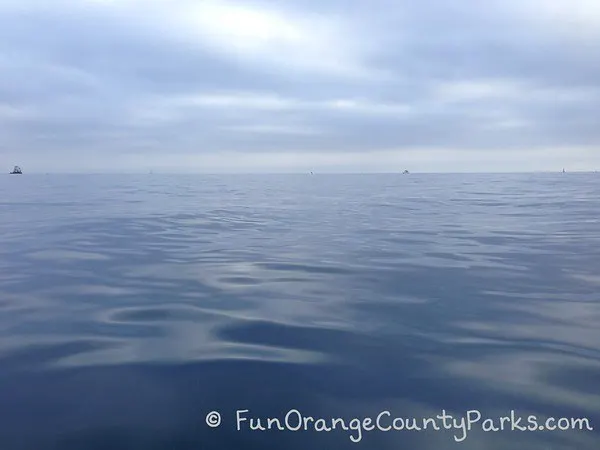
So how can you get out there despite a propensity for seasickness?
Okay, I’m gonna talk you through it. Stick with me, here.
Book Your Trip Early in the Day
I don’t care if you’re not normally an early riser or if you want to maximize your time on the island or out in the ocean. The earlier you leave, the less wind chop there will be. Yes, less bounce. Hurray! If you want to spend the whole day out there, consider spending the night and returning in the morning. Seriously, try to leave early! This is my best tip – an early crossing usually means smooth seas.
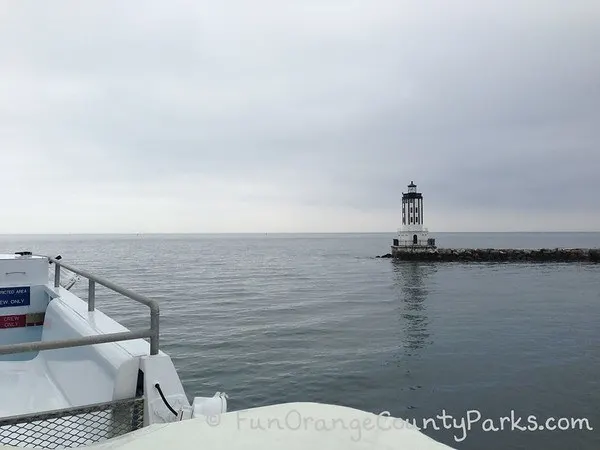
Book the Shortest Route Possible
You might be tempted to head to Catalina from Dana Point, but your time on the ocean will be longer. Why not spend the time on the freeway instead — and shoot right out to the island from San Pedro? For instance, the Catalina Express from Dana Point to Avalon takes approximately 1 hour and 30 minutes – most of it on the open ocean. The San Pedro to Avalon ferry is 1 hour and 15 minutes, but 15-20 minutes of that is slowly exiting the harbor. Research all your options.
Pack Warm Clothes to Wear on the Boat
It may be 90 degrees at your house and 80 degrees on the island, but I recommend bringing a hooded sweatshirt AND a windbreaker to wear over the sweatshirt. Wear long pants and change into shorts when you get there. A ski cap or beanie can keep your ears warm – even bring mittens for your hands. It is ALWAYS windy on the boat. Just the forward progress will have the cold and moist sea air sliding over your skin. You’ll feel silly holding all those warm clothes as you head on the boat, but other passengers will start to look at you admiringly as they suffer through the goosebumps in their shorts and tank top.
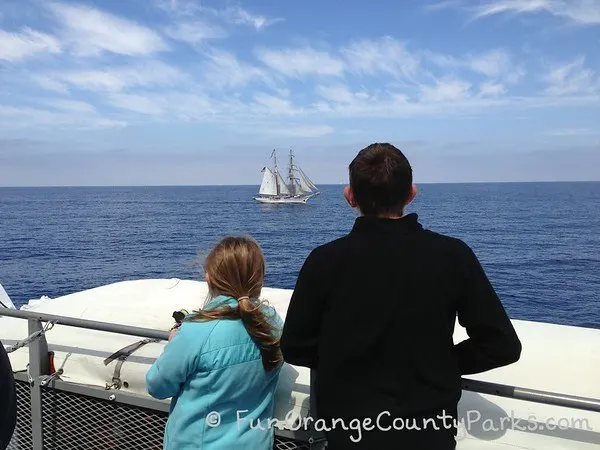
Sit Outside, Facing Forward, Eyes on the Horizon
If you are on a sailboat, the best spot is usually leaning agains the mainsail mast. On the Catalina Ferry, it’s the top deck sitting on the outside-facing bench. Stand up by the rail and look FORWARD at the horizon. The horizon is the straight line between sea and sky. Yes – it WILL be cold – but remember, you packed all your warm clothes. Put them on and enjoy the view. You may be the first to spot dolphins or whales!
I’m sure you’ve heard not to walk around and some even say stay to the the back (stern) of the boat. The stern of the boat is more stable, but it has the downside of not allowing you to see the horizon and also the strong smell of the diesel exhaust. That diesel smell can be just enough to push you over the edge when you’re not feeling quite right. I don’t recommend the stern.
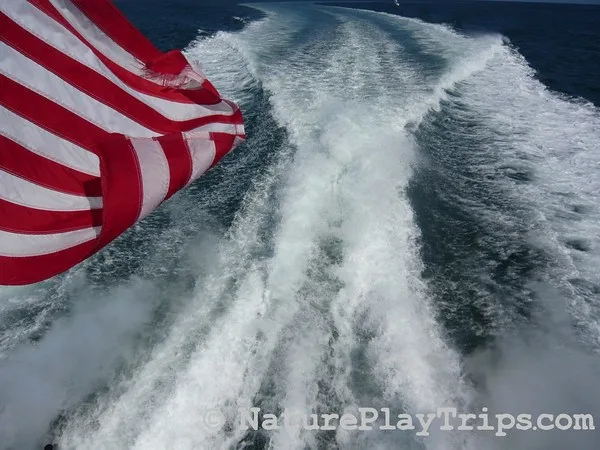
Dramamine – BEFORE You Go
I’m not a doctor, so I’m not giving medical advice here. Talk to your pediatrician or doctor before taking any medication. My daughter’s pediatrician recommended Dramamine and it proved effective for her on a number of trips. The trick is to take it BEFORE you go. If you take it when you are already starting to feel sick, then it’s too late and it won’t be as effective.
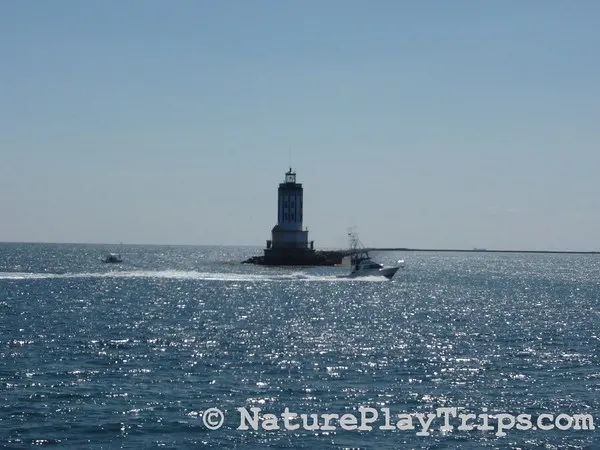
Other tips:
- If you are unsure of your seaworthiness, try a short trip first. See how you do and then you can plan for longer trips.
- Bring an air sickness bag – or other personal container. Over the side or into a trash can just stress you out more.
- NEVER go into the restroom (called “head” on the boat) while the boat is underway. Ugh! You can’t see the horizon and it will certainly mess you up!
- Don’t go on an empty or full stomach. Dairy is not a good choice. Think of eating something bland like toast or oatmeal before your trip.
- It may be a “party weekend” or celebration — but save your alcohol consumption for dry land. Even if you don’t normally get seasick, drinking can make it bad scene.
- My mom swears by staying on a task — count the number of seagulls, or the number of different boats you see. Make something up to keep yourself busy – and your mind off of your stomach – while you’re staring out into the distance.
- My outdoor family blogger friend, Erin at AKontheGo.com, wrote about Helping Kids Cope with Motion Misery

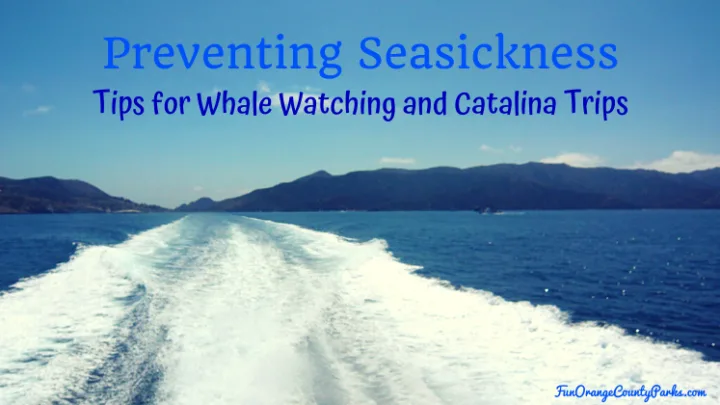
Gigi
Monday 12th of August 2013
All great advice! Where were you when I began boating?!! ;-)
Kate
Monday 12th of August 2013
I love boats too, and we don't get seasick (probably because all of our boating is on lakes) but cars are a whole other story... I did a post on motion sickness too - it's caused by your ears! http://beansandbunny.blogspot.ca/2013/07/road-trip-with-bags.html
Victor Michael
Monday 12th of August 2013
Great post! I'm an avid sea kayaker and don't get sea sickness myself, but I know that Ginger is an often used remedy for a not-right tummy. I use it when I'm not right for other reasons and it works well. One Catalina Ferry service actually sells The Ginger People's Ginger Chews at their snack bar.
If you can prevent the sickness, it's so worth being on the water!
Cheers!